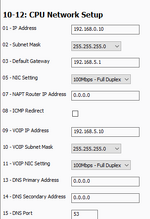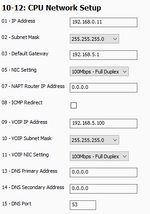Hang on here, the OP hasn't said there are Sip trunk connections between the two systems or any other connection for that matter (other than ethernet). Why is the OP just assuming the two systems can route between each other just because of an ethernet connection? How are the two systems actually connected from a voice point of view and has any Froute programming been done?
Thanks for the reply, I'm viewing the backup of both systems, on the main SL 2100
Looking via quick install
Quick Install/Trunks/SIP Trunks/Profile 1/Interconnect IP without registration/Interconnect Remote Destinations
Sys nº: 0001
System Interconnection: Enable
Ip Address: 192.168.5.100
Call Control Port: 1720
Dial Number: 4
Keep Alive Mode For SIP: Option Keep Alive Mode
Domain Name:
Host Name:
User ID: 100
Domain Assignment: IP Address
SIP Carrier Choice: Carrier B
Register Sub Mode: disabled
User ID is the same number of the op extension number (MLT Phone)
44-02 001
Dial 4 F-Route table
44-05-01 F-Route table
1 = with group 2 (line 4 trough 7 SIP Lines)
10-36-00
Enable , User ID 100, Auth ID and pass empty
On the Second 2100
Quick Install/Trunks/SIP Trunks/Profile/Interconnect IP without Registration/Interconnect Remote Destinations.
Sys nº: 0001
System Interconnection: Enable
Ip Address: 192.168.5.100
Call Control Port: 1720
Dial Number: 4
Keep Alive Mode For SIP: Option Keep Alive Mode
Domain Name:
Host Name:
User ID: 100
Domain Assignment: IP Address
SIP Carrier Choice: Carrier B
Register Sub Mode: disabled
On Repots- Feature activation
5001 IP Terminal
Qty: 1
Status: on
Expires: unlimited
5103 VoIP Channel
Qty: 0
Status: off
Expires: unlimited
5111 IP Terminal
Qty: 1
Status: on
Expires: unlimited
5201 Mobile Extension (the don't use that feature)
Qty: 4
Status: on
Expires: unlimited





